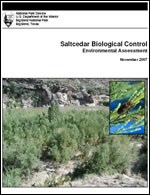
The National Park Service is seeking public comment on a proposal to use a beetle from Asia to help reduce infestations of saltcedar, also known as tamarisk. The proposal is contained in a Draft Environmental Assessment that is available for public review and comment. A native of Asia, the Tamarisk tree has become established in many areas of the South and Southwestern United States. In the Big Bend, the non-native plant can often be found growing in abundance in drainages, near springs and along the banks of the Rio Grande. The National Park Service is responsible for preventing the damage saltcedar causes to natural resources, as it competes with and displaces native species and alters the natural environment. Despite a variety of efforts to reduce or control the spread of saltcedar, including cutting and application of herbicides, no successful and cost-effective long-term control strategy has been developed. After extensive research to ensure the beetle would not feed on native or beneficial plants, the U.S. Department of Agriculture and Bureau of Reclamation have in recent years released the beetle, Diorhabda elongata, into saltcedar infestations elsewhere in the western United States, including near Big Spring, Texas, and along the Rio Grande upstream of Candelaria, Texas. The proposed project would include studies of the beetle’s survival and spread, its effect upon saltcedar, and on the response of native plants and animals. The National Park Service is making the draft document available for a 30-day public review beginning November 5, 2007 and ending December 4, 2007. Public comments will be reviewed and addressed in the Final Environmental Assessment before a decision is made regarding the proposal. The Environmental Assessment is available for review online. Comments may be posted on the PEPC site or mailed to: Superintendent |
Last updated: February 24, 2015
